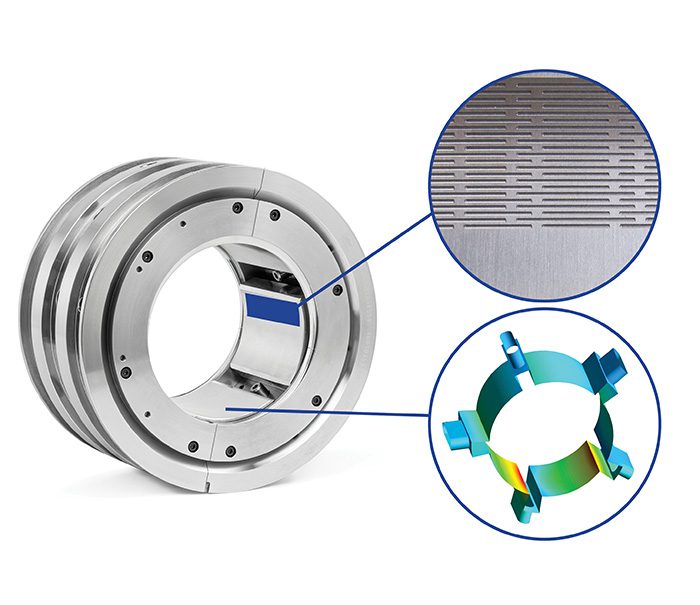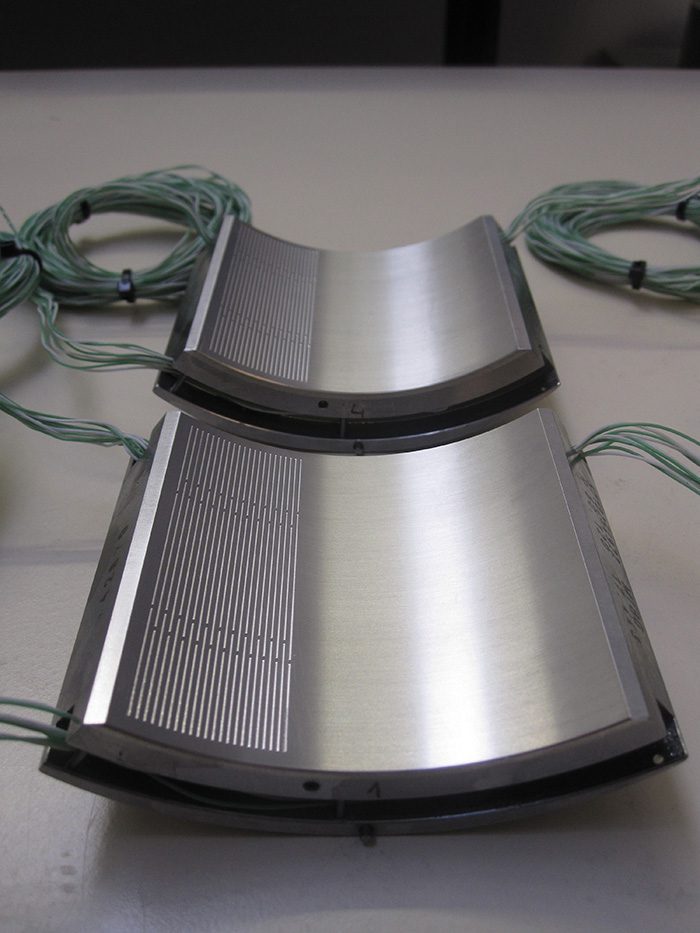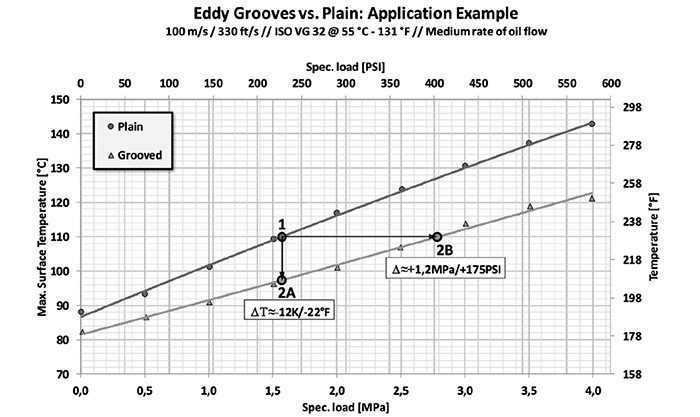Effect of Eddy Grooves on Tilting Pad Journal Bearings
Tilting pad journal bearings are used in turbomachinery such as turbo compressors, turbo gears, gas turbines, or steam turbines. There is an ongoing and growing customer demand for bearings with increased load-carrying capacity or power density.
It’s important these goals be achieved without an impairment of bearing functionality and operational reliability. Traditional bearings or better standard bearing designs have performance limits, and these limits often are reached or even exceeded in turbomachinery applications for a variety of reasons.
To overcome conservative operational limits, it is helpful to reduce the oil film temperatures. This can be done by certain design modifications or optimizations.
Heat Dissipation
A basic prerequisite for the safe and reliable operation of bearings is a sufficient lubricant film thickness, which basically depends on the occurring load, speed, and the selected lubricant. During operation, heat is generated in both the oil and parts of the bearing. Because of this, the temperature of the oil and the bearing are important parameters.
An increase of heat dissipation (Figure 1), which means heat is transferred from hotter to colder areas—away from the loaded pads or areas of the bearing—is key to improve bearing performance. It is common practice to accommodate design features to adapt the bearing accordingly.
 |
|
1. New technology for eddy grooves, including this design from Miba Industrial Bearings, increases the heat dissipation in turbomachinery bearings, helping improve performance. Courtesy: Miba Industrial Bearings |
The use of features like directed lubrication, and pad base materials with a high thermal conductivity, are a common practice to increase the heat dissipation. If this approach is still insufficient, there are geometric options, such as an increase of the axial length or the bore diameter of the bearing.
Such changes, though, could increase oil demand, cause a loss of power, and also increase space requirements. That is why in some cases, geometric modifications of bearings in operation in turbomachinery are not feasible.
Eddy Grooves Improve Safety, Performance
Eddy grooves are a hydrodynamic bearing feature that improve operational safety and performance. The effectiveness of this technology was proved experimentally and a significant reduction of maximum bearing temperatures due to eddy grooves was achieved, especially at higher bearing loads, under otherwise identical operating conditions. The reduced bearing temperatures, induced by eddy grooves, can be utilized to:
■ Increase the safety margin of the bearing and slow down the lubricating oil aging.
■ Operate bearings at higher loads without an increase of maximum temperatures.
■ Decrease the bearing diameter or the axial length to reduce the power loss and the necessary rate of oil supply without an increase of maximum bearing temperatures.
New technology is being used along with traditional design adaptations in rotating equipment. Miba Industrial Bearings produces hydrodynamic bearings and labyrinth seals used in turbines, compressors, generators, motors, and industrial pumps, along with fluid film bearings used in power generation as well as in the oil and gas industry and the petrochemical industry.
In Miba’s designs, robust grooves are machined into a specific area of the bearing material (Figure 2). The grooves are optimized to disturb the laminar lubricant flow, which is converted into a turbulent flow. This creates a cooling effect by improving temperature exchange between cooler oil near the shaft and warmer oil near the bearing surface.
 |
|
2. These radial tilting pads are equipped with Miba-designed eddy grooves, which are machined into an area of the bearing material. Courtesy: Miba Industrial Bearings |
The foundation of this technology has been known for more than 30 years, and the possibilities of improvement are clear. It is possible to push performance limits upward without changing the bearing, or the bearing housing design, thus maintaining or even improving the reliability and operational safety of the bearing and the turbomachine.
Performance Improvement
To investigate on the exact design and position of the grooves, Miba carried out a study on a journal bearing test rig using a five-tilting-pad journal bearing with 120-millimeter (mm) shaft diameter at a speed between 50 meters per second (m/s) and 110 m/s and a load of 0 Megapascal (MPa) to 4 MPa.
Temperature sensors close to the sliding surface enabled Miba to precisely determine the maximum temperatures. The results of the study confirmed a significant surface temperature reduction. Figure 3 is a Miba eddy groove application example operating at a speed of 100 m/s, inlet oil temperature of 55C, and medium oil flowrate. With the Miba eddy groove modification of the bearing, opportunities arise to either use the benefit solely for a temperature reduction by 12K, thereby increasing the operational safety of the bearing, indicated by point 2A, or use the full benefit to increase the bearing load at a constant maximum temperature, shown as point 2B. A new point of operation between 2A and 2B would result, compared to point 1, in a reduced bearing temperature in combination with an increased bearing load.
 |
|
3. This chart provides a comparison of the maximum running surface temperatures of a bearing with and without eddy grooves at a speed of 100 meters per second, inlet oil temperature of 55C, and medium oil flowrate. Courtesy: Miba Industrial Bearings |
The technology has been tested on shaft diameters of 120 mm and 500 mm. The effects on other bearing sizes are yet to be proven. In theory, smaller bearings with smaller pad size and consequently tinier grooves could face the problem of not reaching a sufficient flow change.
“From the very beginning, we were convinced that we could successfully develop this technology,” a spokesperson for Miba Industrial Bearings Germany said. “Of course, intensive preliminary consideration has been put into design of the Miba eddy grooves. In addition, many tests on our own test rig were necessary to determine the exact design parameters. However, the positive effect on the overall temperature level in the bearing was observed from the very first tests on.”
Operational Advantages
The application of Miba’s eddy groove technology could be especially beneficial for highly loaded bearings that operate near their performance limits. The use of this technology can help to increase the reliability and slow the aging of the lubricating oil. In practice, it is possible to operate bearings at higher loads without an increase of maximum temperatures, or reduce the bearing diameter or the axial length with the aim of reducing the necessary oil supply and the power loss without having to accept an increase in the maximum bearing temperatures.
For example, when designing different compressor types, engineers often face problems regarding the limited space for the bearing housing. The Miba eddy groove bearings can provide a solution, with smaller sizes than conventional bearings while reaching the same temperature level. The technology is already available to the market and the first bearings with Miba eddy grooves have already been successfully installed at customers’ plants.
—Stephen Faulhaber is technical manager at Miba Industrial Bearings Germany. Eckhard Schueler is a senior research and development engineer at Miba. Learn more at www.miba.com/en/product-areas/industrial-bearings.